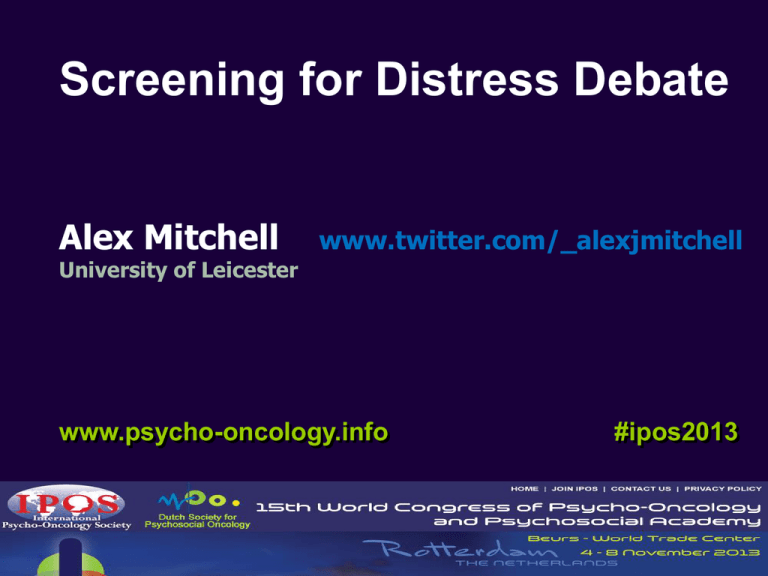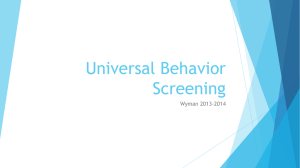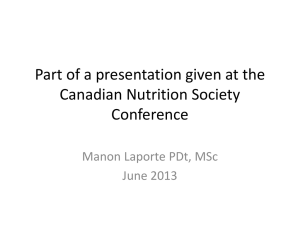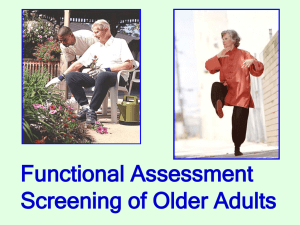Screening tools - Psycho
advertisement

Screening for Distress Debate Alex Mitchell www.twitter.com/_alexjmitchell University of Leicester www.psycho-oncology.info #ipos2013 …What are the sources of disagreement? Areas of Disagreement: 1. 2. 3. 4. 5. 6. How to screen (which tool) When to screen How often to screen Which screening population Who should screen Does screening work ……in short Should we screen at all? But what are the alternatives to screening? 1. Diagnosis as usual (do nothing) 2. Enhanced diagnosis (clinician = screen) 3. Screen everyone 4. Screen high risk (targeted screening) 100.0 5.9 11.1 90.0 21.4 25.9 Comment: Slide illustrates diagnostic accuracy according to score on DT 38.7 80.0 43.5 14.3 11.8 38.1 22.2 46.7 14.3 59.6 70.0 21.4 72.4 Judgement = Non-distressed 60.0 33.3 19.4 50.0 Judgement = Unclear Judgement = Distressed 19.0 26.1 82.4 24.4 40.0 71.4 66.7 30.0 57.1 25.0 20.0 15.8 30.4 28.9 Two Three 41.9 42.9 40.7 Four Five Six 10.0 11.8 15.4 0.0 Zero One Seven Eight Nine Ten Lessons from primary care…. Results disappointing Acceptability overlooked Most are not depressed Many do not want help Some are already Rx Screening in Cancer Missed diagnosis GP = CNS = Oncologists Screening tools (validity) Depression Distress Brief / ultra-short Multi-domain Implementation evidence Randomized Non-Randomized Q. What type of studies? Q. How many +ve studies? Q. What are the beneficial outcomes? Q. What is the size of the effect? Implementation Reviews Implementation Studies 9 studies Distress => 6 studies => Referral Communication ….this is getting complex……. ………………..what is the overall effect? Overall Effect of screening Baseline CARE x% with screening +10% (0-20%) Overall Effect of screening Baseline CARE x% with screening +10% + follow-up +treatment +10% +10% What is holding back screening success? BOTH. How Many Receive Ps Help? (n=2557) Proportion meta-analysis plot [random effects] Kadan-Lottick et al (2005) 0.89 (0.77, 0.96) Plass and Koch (2001) 0.60 (0.46, 0.72) Siedentopf et al (2009) 0.46 (0.35, 0.58) Fritsche et al (2004) 0.43 (0.28, 0.59) Bogaarts et al (2011) 0.38 (0.27, 0.49) Söllner et al (2004) 0.35 (0.26, 0.45) Shimizu et al (2005) 0.28 (0.18, 0.41) Shimizu et al (2009) 0.25 (0.18, 0.33) Merckaert et al (2009) 0.21 (0.17, 0.25) Morasso et al (2010) 0.16 (0.05, 0.33) Sharpe et al (2004) 0.15 (0.10, 0.22) McDowell et al (2010) 0.14 (0.11, 0.18) combined 0.35 (0.25, 0.46) 0.0 0.2 0.4 0.6 proportion (95% confidence interval) 0.8 1.0 12mo Service Use (NIH, 2002) 40 34.6 32.7 35 Cancer n=4878 No Cancer n=90,737 30 25 19.1 20 16.1 % Receiving Any treatment for Mental Health 14 15 10 11.7 11 7.2 5.7 5.7 5 6.3 6.4 5 8.9 7.7 6.5 6.2 3.9 5 2.3 3.2 1.8 75+ y ea rs 6574 y ea rs 4564 y ea rs 1844 con diti o ns hro nic me di ca l 3c 2c hro nic me di ca l con diti o ns con diti o n hro nic me di ca l 1c No c hr o ni cm edi cal con d iti ons Hea l th No Me n ta l Il l eal th Il l H Me nt a l Al l P atie nt s 0 Maria Hewitt, Julia H. Rowland Mental Health Service Use Among Adult Cancer Survivors: Analyses of the National Health Interview Survey Journal of Clinical Oncology, Vol 20, Issue 23 (December), 2002: 4581-4590 Overall Effect of screening Baseline CARE x = 35% with screening +10% (0-20%) + follow-up +treatment +10% (0-20%) +10% (0-20%) ……..So is screening successful or not? …….It depends Analogy: How do we reduce speeding drivers? US deaths 10,000 Analogy Aim is to reduce speed (and hence deaths) Not simply to detect speeding! Aim is to reduce distress (improving QoL) Not simply to detect distress! 1 2 3 0. Summary Screening can be ineffective or effective Screening may be optional or mandated





